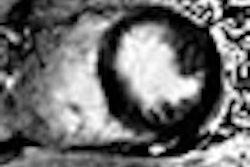CHICAGO - The use of breast MRI has increased by double-digits this year, a boost some industry watchers attribute to increased awareness of how the technology helps clinicians detect and treat breast cancer earlier in high-risk women.
But can MRI also help clinicians predict whether biopsy-diagnosed malignancies will prove to be invasive cancer at surgery? Researchers from the University of Udine in Italy compared mammographic and MRI features to address this question. They presented their findings at the RSNA meeting in Chicago.
Dr. Nicoletta Martini and colleagues included 86 cases in the study, 80 of which were diagnosed by biopsy as ductal carcinoma in situ (DCIS) and six of which were diagnosed as suspected invasive cancer. Surgery confirmed 65 DCIS cases and 21 cases of invasive cancer.
Mammography exams identified 61 of the 65 DCIS cases (93.8%) and all of the invasive cancer cases as microcalcifications or mass/density, while breast MRI, performed with a 1.5-tesla magnet, found 52 cases of DCIS (80%) and all of the invasive cancers. The MRI scans also found four DCIS cases that mammography didn't find, according to Martini.
Mammography features that showed a positive predictive value (PPV) or negative predictive value (NPV) for the presence of invasive cancer at surgery included the following:
|
Contrast-enhanced masses with suspicious morphologic or kinetic features on MRI had a PPV of 100% (no DCIS, 14 invasive cancer), while non-masslike enhancements had an NPV of 88.1% (all 52 DCIS, 7 invasive cancer).
No statistically significant differences for predicting DCIS at surgery were seen between the NPV of non-masslike enhancement on MRI and the absence of mass/density on mammograms, the morphology of microcalcifications, or the size of the tumors, Martini said.
The team found that invasive cancer could not be ruled out on the basis of either MRI or mammographic features, but nevertheless, the negative predictive value of non-masslike contrast enhancements on MRI was "remarkable."
"A suspicious enhancing mass on MRI was strongly associated with the presence of invasive cancer within DCIS at surgery, while mammographic findings were not reliable as predictors of invasive cancer," Martini said.
By Kate Madden Yee
AuntMinnie.com staff writer
December 1, 2008
Related Reading
Preoperative breast MRI boosts breast conservation, October 9, 2008
Routine MRI at breast cancer diagnosis linked to treatment delays, September 9, 2008
Breast MRI develops role as surgical planning tool, September 2, 2008
The comprehensive breast center: Greater than the sum of its parts, September 2, 2008
Preoperative MRI helps detect additional breast cancer, but may delay treatment, July 25, 2008
Copyright © 2008 AuntMinnie.com



.fFmgij6Hin.png?auto=compress%2Cformat&fit=crop&h=100&q=70&w=100)





.fFmgij6Hin.png?auto=compress%2Cformat&fit=crop&h=167&q=70&w=250)











